
The 1899 VFL season was the third season of the Victorian Football League (VFL), the highest-level senior Australian rules football competition in Victoria. The season featured eight clubs and ran from 13 May to 16 September, comprising a 14-round home-and-away season followed by a finals series featuring all eight clubs.

The 1905 VFL season was the ninth season of the Victorian Football League (VFL), the highest-level senior Australian rules football competition in Victoria. The season featured eight clubs and ran from 6 May to 30 September, comprising a 17-match home-and-away season followed by a three-week finals series featuring the top four clubs.
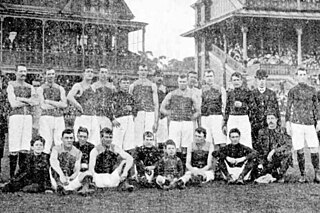
The 1908 VFL season was the twelfth season of the Victorian Football League (VFL), the highest-level senior Australian rules football competition in Victoria. The season featured ten clubs and ran from 2 May to 26 September, comprising an 18-match home-and-away season followed by a three-week finals series featuring the top four clubs. Victorian Football Association (VFA) club Richmond and Metropolitan Junior Football Association (MJFA) club University featured for the first time in 1908.

The 1917 VFL season was the 21st season of the Victorian Football League (VFL), the highest-level senior Australian rules football competition in Victoria. Played during the latter stages of World War I, six of the league's nine clubs featured in 1917, with Geelong and South Melbourne returning after being in recess the previous season. The season ran from 12 May to 22 September, comprising a 15-match home-and-away season followed by a four-week finals series featuring the top four clubs.
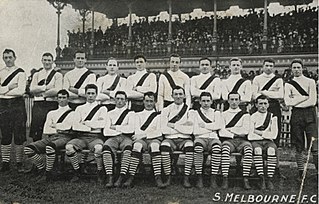
The 1909 VFL season was the 13th season of the Victorian Football League (VFL), the highest-level senior Australian rules football competition in Victoria. The season featured ten clubs and ran from 1 May to 2 October, comprising an 18-match home-and-away season followed by a four-week finals series featuring the top four clubs.
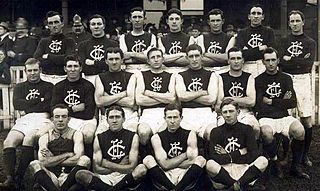
The 1914 VFL season was the 18th season of the Victorian Football League (VFL), the highest-level senior Australian rules football competition in Victoria. The season featured ten clubs and ran from 25 April to 26 September, comprising an 18-match home-and-away season followed by a four-week finals series featuring the top four clubs. It was the last season to feature University, which withdrew from the VFL after seven seasons after its strict policy of amateurism when player payments were becoming common, and its players focusing primarily on their studies, meant that the club could not remain competitive or viable in the league.

The 1915 VFL season was the 19th season of the Victorian Football League (VFL), the highest-level senior Australian rules football competition in Victoria. The season featured nine clubs and ran from 24 April to 18 September, comprising a 16-match home-and-away season followed by a four-week finals series featuring the top four clubs.
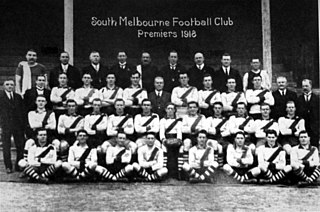
The 1918 VFL season was the 22nd season of the Victorian Football League (VFL), the highest-level senior Australian rules football competition in Victoria. Played during the final year of World War I, eight of the league's nine clubs featured in 1918, with Essendon and St Kilda returning after being in recess the previous two seasons and only Melbourne absent. The season ran from 11 May to 7 September, comprising a 14-match home-and-away season followed by a three-week finals series featuring the top four clubs.
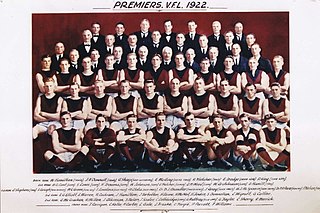
The 1922 VFL season was the 26th season of the Victorian Football League (VFL), the highest level senior Australian rules football competition in Victoria. The season featured nine clubs, ran from 6 May until 14 October, and comprised a 16-game home-and-away season followed by a finals series featuring the top four clubs.
The 1959 VFL season was the 63rd season of the Victorian Football League (VFL), the highest level senior Australian rules football competition in Victoria. The season featured twelve clubs, ran from 18 April until 26 September, and comprised an 18-game home-and-away season followed by a finals series featuring the top four clubs.
The 1962 VFL season was the 66th season of the Victorian Football League (VFL), the highest level senior Australian rules football competition in Victoria. The season featured twelve clubs, ran from 21 April until 29 September, and comprised an 18-game home-and-away season followed by a finals series featuring the top four clubs.
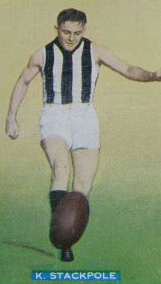
The 1935 VFL season was the 39th season of the Victorian Football League (VFL), the highest level senior Australian rules football competition in Victoria. The season featured twelve clubs, ran from 27 April until 5 October, and comprised an 18-game home-and-away season followed by a finals series featuring the top four clubs.

The 1936 VFL season was the 40th season of the Victorian Football League (VFL), the highest level senior Australian rules football competition in Victoria. The season featured twelve clubs, ran from 2 May until 3 October, and comprised an 18-game home-and-away season followed by a finals series featuring the top four clubs.

The 1940 VFL season was the 44th season of the Victorian Football League (VFL), the highest level senior Australian rules football competition in Victoria. The season featured twelve clubs, ran from 27 April until 28 September, and comprised an 18-game home-and-away season followed by a finals series featuring the top four clubs.
The 1941 VFL season was the 45th season of the Victorian Football League (VFL), the highest level senior Australian rules football competition in Victoria. The season featured twelve clubs, ran from 26 April until 27 September, and comprised an 18-game home-and-away season followed by a finals series featuring the top four clubs.
The 1966 VFL season was the 70th season of the Victorian Football League (VFL), the highest level senior Australian rules football competition in Victoria. The season featured twelve clubs, ran from 23 April until 24 September, and comprised an 18-game home-and-away season followed by a finals series featuring the top four clubs.

The 1944 VFL season was the 48th season of the Victorian Football League (VFL), the highest level senior Australian rules football competition in Victoria.
The 1972 VFL season was the 76th season of the Victorian Football League (VFL), the highest level senior Australian rules football competition in Victoria. The season featured twelve clubs, ran from 1 April until 7 October, and comprised a 22-game home-and-away season followed by a finals series featuring the top five clubs – an increase from the four clubs which had contested the finals in previous years.
The 1973 VFL season was the 77th season of the Victorian Football League (VFL), the highest level senior Australian rules football competition in Victoria. The season featured twelve clubs, ran from 7 April until 29 September, and comprised a 22-game home-and-away season followed by a finals series featuring the top five clubs.
The 1976 VFL season was the 80th season of the Victorian Football League (VFL), the highest level senior Australian rules football competition in Victoria. The season featured twelve clubs, ran from 3 April until 25 September, and comprised a 22-game home-and-away season followed by a finals series featuring the top five clubs.













